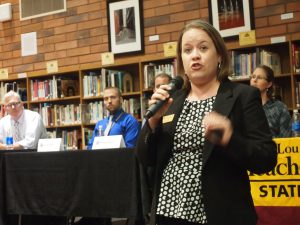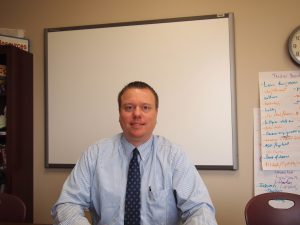- Slug: Teacher shortage, 1,000
- Photos available (thumbnails, captions below)
By PETER CHENG
Cronkite News
GILBERT – Suzanne Zentner stood in front of the high school students and their parents gathered in the library of Gilbert High School on a recent evening and got right to the point.
“Instead of dancing around issues, I’m going to find the elephant in the room, and I’m going to hit it,” Zentner told them. “The biggest myth out there, and I’m going to challenge that myth, is that there is no way you can make a living as a teacher.”
The crowd had gathered because the students had expressed interest in teaching. They are taking part in Aim2Teach, a program aimed at identifying students who may want to teach and helping guide them into professional teaching programs.
But Zentner, chief talent officer for Gilbert Public Schools, and her colleagues face an uphill battle. And they’ve realized one of the obstacles they must overcome is not just convincing the students to pursue the profession – but they must win over their parents as well.
Local administrators and educators are utilizing creative techniques to deal with Arizona’s chronic teacher shortage from a recruitment perspective as well as how to use the limited supply of qualified teachers in the most effective way.
The Learning Policy Institute, a national nonprofit, nonpartisan organization that researches education policy and practice, ranked Arizona at the bottom of its teacher attractiveness rating scale. The state ranks worst overall in teacher compensation, level of teacher qualification and turnover.
“There’s over 2,000 vacant teaching position right now. That’s the highest I’ve seen it in recent years,” said Erin Hart, CEO of Expect More Arizona, a nonprofit education advocacy group. “We’ve got a teacher crisis on our hands for sure. There’s no question about that. It’s an issue of both people getting into the profession and staying.”
The biggest obstacles to teacher recruitment are pay and “the perception of the profession,” said Jenna Kahl, director of enrollment at the Arizona State University Mary Lou Fulton Teachers College, which created the Aim2Teach program. “It’s not a real career. You’re a glorified babysitter. And people hear in the media about turnover rates and teachers are getting cut. It all slams together and turns into one big warning sign.”
Justin Wing, president of the Arizona School Personnel Administrators Association, a group that represents human resources professionals and advocates for public education policy, said his organization conducted three school district surveys measuring teacher vacancies between August 2015 and August 2016. During that time, survey participation increased from 61 to 130 school districts and charter schools.
“Why do you suspect there’s been such an increase (in participation)? Because there’s a deep concern,” Wing said.
The most recent of the surveys indicated that the state has more than 2,000 teaching position vacancies. And there are nearly 2,000 more positions filled by teachers “not meeting standard teacher requirements.”
“We can’t use out-of-state recruitment as our No. 1 recruiting strategy. Imagine parking your recruiting booth next to Texas that starts at $48,000,” Wing said. “Are you going to go the state that pays $48,000 or the state that pays $36,000?”
Aim2Teach partners with school districts to hold events like the one in Gilbert. It also provides students with scholarships and assists them with college enrollment and financial aid applications.
At Gilbert High School, Zentner tried to mitigate the pay concerns by pumping up benefits like strong health insurance and retirement programs.
Kahl said both parents and teachers often advise young people against the profession, and part of her job is to turn teachers and parents into advocates.
“Five years ago, if we would have done this, it would have been all about the students. This is all about the parents,” Kahl said. “Students don’t care about retirement benefits, we have to convince the parents.”
Ashlee Davis, a Mesquite High School sophomore who attended the event with her mother, said she was not concerned with teacher compensation.
“I’ve been saying I want to be a teacher since the third grade,” she said. “I like teaching people things and giving them an opportunity to do the things they want to do.”
Her mother, LaShunda Davis, supported her decision.
Kahl said “grow your own teacher” programs like Aim2Teach can be effective because “the data shows us that students go back to where they went. Eighty percent of new teachers return to within 40 miles of the schools they went to.” The Arizona Department of Education found that 89 percent of teachers recruited from out of state leave the district in which they were hired within five years.
Wing, who is also the director of human resources for the Washington Elementary School District, agrees with Kahl. “With my HR hat on teacher pay is the No. 1 issue. No. 2 is the image of the profession. Millennials are the first generation whose parents have advised them against teaching,” he said.
Low pay is still the greatest obstacle to finding and keeping good teachers in the state, he said.
The Washington Elementary District in Phoenix, the largest elementary school district in the state, is experimenting with alternative staffing methods to deal with the lack of highly qualified teachers.
“What we’re piloting at one school, at one grade level, is recognizing our master teacher and getting the master teacher to see more students and still having a great education for kids despite not having teacher jobs filled,” Wing said.
The program is being piloted for fourth grade students at Chaparral Elementary School in Phoenix. The school has three fourth-grade classes but only two teachers because it could not find a third qualified candidate, Wing said.
Rather than have two classrooms of nearly 50 students, Chaparral has retained three classrooms overseen by two master teachers and one para-professional. The master teachers create the lesson plan and the three instructors rotate between classrooms rather than have the students move.
“We’re going out of the box and thinking not just ‘This classroom is my classroom, but every classroom is my classroom, all of these kids are my kids’,” Wing said. The three instructors do receive some additional compensation for their added responsibilities, and the money comes from what would have been paid to a third teacher.
Wing said the idea is gaining traction: “Two school districts and the Department of Education want to visit Chaparral because they’re desperate to get great teachers into every class.”
Chaparral Principal Rich Morris said this approach “can’t be duplicated all the time, everywhere, but there are different models.” He referenced the Charlotte-Mecklenburg School District in North Carolina, which is “using 21 different models to make the learning equitable.”
^__=


